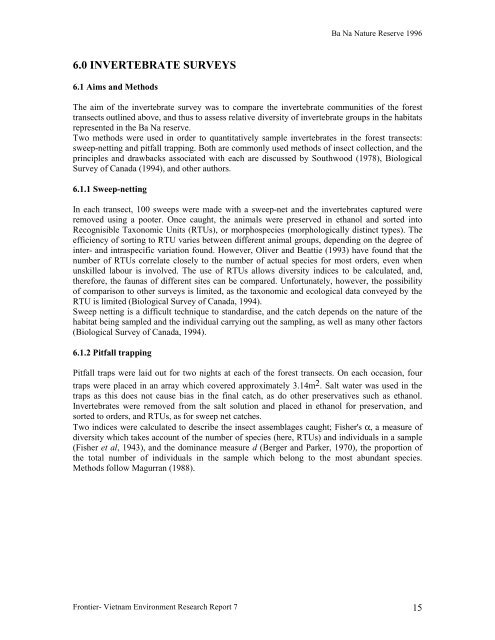Frontier Tanzania Environmental Research - Frontier-publications ...
Frontier Tanzania Environmental Research - Frontier-publications ...
Frontier Tanzania Environmental Research - Frontier-publications ...
Create successful ePaper yourself
Turn your PDF publications into a flip-book with our unique Google optimized e-Paper software.
Ba Na Nature Reserve 1996<br />
6.0 INVERTEBRATE SURVEYS<br />
6.1 Aims and Methods<br />
The aim of the invertebrate survey was to compare the invertebrate communities of the forest<br />
transects outlined above, and thus to assess relative diversity of invertebrate groups in the habitats<br />
represented in the Ba Na reserve.<br />
Two methods were used in order to quantitatively sample invertebrates in the forest transects:<br />
sweep-netting and pitfall trapping. Both are commonly used methods of insect collection, and the<br />
principles and drawbacks associated with each are discussed by Southwood (1978), Biological<br />
Survey of Canada (1994), and other authors.<br />
6.1.1 Sweep-netting<br />
In each transect, 100 sweeps were made with a sweep-net and the invertebrates captured were<br />
removed using a pooter. Once caught, the animals were preserved in ethanol and sorted into<br />
Recognisible Taxonomic Units (RTUs), or morphospecies (morphologically distinct types). The<br />
efficiency of sorting to RTU varies between different animal groups, depending on the degree of<br />
inter- and intraspecific variation found. However, Oliver and Beattie (1993) have found that the<br />
number of RTUs correlate closely to the number of actual species for most orders, even when<br />
unskilled labour is involved. The use of RTUs allows diversity indices to be calculated, and,<br />
therefore, the faunas of different sites can be compared. Unfortunately, however, the possibility<br />
of comparison to other surveys is limited, as the taxonomic and ecological data conveyed by the<br />
RTU is limited (Biological Survey of Canada, 1994).<br />
Sweep netting is a difficult technique to standardise, and the catch depends on the nature of the<br />
habitat being sampled and the individual carrying out the sampling, as well as many other factors<br />
(Biological Survey of Canada, 1994).<br />
6.1.2 Pitfall trapping<br />
Pitfall traps were laid out for two nights at each of the forest transects. On each occasion, four<br />
traps were placed in an array which covered approximately 3.14m 2 . Salt water was used in the<br />
traps as this does not cause bias in the final catch, as do other preservatives such as ethanol.<br />
Invertebrates were removed from the salt solution and placed in ethanol for preservation, and<br />
sorted to orders, and RTUs, as for sweep net catches.<br />
Two indices were calculated to describe the insect assemblages caught; Fisher's α, a measure of<br />
diversity which takes account of the number of species (here, RTUs) and individuals in a sample<br />
(Fisher et al, 1943), and the dominance measure d (Berger and Parker, 1970), the proportion of<br />
the total number of individuals in the sample which belong to the most abundant species.<br />
Methods follow Magurran (1988).<br />
<strong>Frontier</strong>- Vietnam Environment <strong>Research</strong> Report 7 15
















